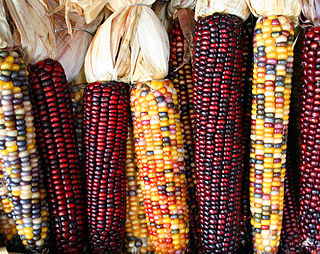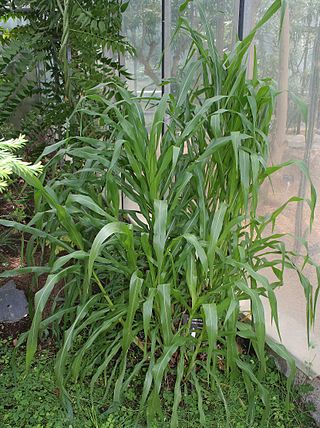
Sorghum or broomcorn is a genus of about 25 species of flowering plants in the grass family (Poaceae). Some of these species are grown as cereals for human consumption, in pastures for animals as fodder, and as bristles for brooms. Sorghum grain is a nutritious food rich in protein, dietary fiber, B vitamins, and minerals.

Triticale is a hybrid of wheat (Triticum) and rye (Secale) first bred in laboratories during the late 19th century in Scotland and Germany. Commercially available triticale is almost always a second-generation hybrid, i.e., a cross between two kinds of primary (first-cross) triticales. As a rule, triticale combines the yield potential and grain quality of wheat with the disease and environmental tolerance of rye. Only recently has it been developed into a commercially viable crop. Depending on the cultivar, triticale can more or less resemble either of its parents. It is grown mostly for forage or fodder, although some triticale-based foods can be purchased at health food stores and can be found in some breakfast cereals.

Zea is a genus of flowering plants in the grass family. The best-known species is Z. mays, one of the most important crops for human societies throughout much of the world. The four wild species are commonly known as teosintes and are native to Mesoamerica.

Antirrhinum is a genus of plants commonly known as dragon flowers or snapdragons because of the flowers' fancied resemblance to the face of a dragon that opens and closes its mouth when laterally squeezed. They are also sometimes called toadflax or dog flower. They are native to rocky areas of Europe, the United States, Canada, and North Africa. Antirrhinum species are widely used as ornamental plants in borders and as cut flowers.
Internal transcribed spacer (ITS) is the spacer DNA situated between the small-subunit ribosomal RNA (rRNA) and large-subunit rRNA genes in the chromosome or the corresponding transcribed region in the polycistronic rRNA precursor transcript.

Brachypodium distachyon, commonly called purple false brome or stiff brome, is a grass species native to southern Europe, northern Africa and southwestern Asia east to India. It is related to the major cereal grain species wheat, barley, oats, maize, rice, rye, sorghum, and millet. It has many qualities that make it an excellent model organism for functional genomics research in temperate grasses, cereals, and dedicated biofuel crops such as switchgrass. These attributes include small genome diploid accessions, a series of polyploid accessions, a small physical stature, self-fertility, a short lifecycle, simple growth requirements, and an efficient transformation system. The genome of Brachypodium distachyon has been sequenced and published in Nature in 2010.

Hugh Iltis was a professor of botany and director of the herbarium at the University of Wisconsin–Madison. While he is most noted as a scientist for his role in the discovery of perennial teosinte, a wild diploid relative of modern maize, he is also remembered as an outspoken environmental conservationist.

Sidalcea is a genus of the botanical family Malvaceae. It contains several species of flowering plants known generally as checkerblooms or checkermallows, or prairie mallows in the United Kingdom. They can be annuals or perennials, some rhizomatous. They are native to West and Central North America.
A doubled haploid (DH) is a genotype formed when haploid cells undergo chromosome doubling. Artificial production of doubled haploids is important in plant breeding.

Hordeum brachyantherum, known by the common name meadow barley, is a species of barley. It is native to western North America from Alaska to northern Mexico, coastal areas of easternmost Russia (Kamchatka), and a small area of coastal Newfoundland.

Maize, also known as corn in North American and Australian English, is a cereal grain first domesticated by indigenous peoples in southern Mexico about 10,000 years ago. The leafy stalk of the plant gives rise to inflorescences which produce pollen and separate ovuliferous inflorescences called ears that when fertilized yield kernels or seeds, which are botanical fruits. The term maize is preferred in formal, scientific, and international usage as the common name because it refers specifically to this one grain whereas corn refers to any principal cereal crop cultivated in a country. For example, in North America and Australia corn is often used for maize, but in England and Wales it can refer to wheat or barley, and in Scotland and Ireland to oats.
Teosintes are several wild species of grass in the genus Zea which are critical components of maize evolution.

Psathyrostachys juncea is a species of grass known by the common name Russian wildrye. It was formerly classified as Elymus junceus. It is native to Russia and China, and has been introduced to other parts of the world, such as Canada and the United States. Psathyrostachys juncea is a great source of food for grazing animals, as it has high nutrition value in its dense basal leaves, even in the late summer and autumn seasons. This species can grow and prosper in many harsh environments, making it an ideal candidate for improvement as it can grow in areas were farming is difficult. This species is a drought-resistant forage plant and can survive during the cool seasons. It is also a cross-pollinator and is self-sterile. This means that P. juncea cannot self-fertilize; it must find another plant of the same species with which to exchange gametes. Self-sterilization increases the genetic diversity of a species.
Commonly known as Philippine downy mildew, this disease is caused by the species Peronosclerospora philippinensis of the fungal-like protist class Oomycetes, which also has members such as water molds and Phytophthora infestans, which caused the potato blight that led to the Great Irish famine.

Hugueninia tanacetifolia, the tansy-leaved rocket, is a species of flowering plant in the monotypic genus Hugueninia belonging to the family Brassicaceae. Sometimes it is placed in genus Sisymbrium. Molecular genetic studies have shown it to be most closely related to, and possibly ancestral to the Canary Islands endemic species within the genus Descurainia.

Zea diploperennis, the diploperennial teosinte, is a species of grass in the genus Zea and a teosinte. It is perennial.

Zea luxurians, also referred to by the common names Maíz de Monte, Florida teosinte and Guatemalan teosinte, is a species of flowering plant in the family Poaceae. It is a true grass and a teosinte.
Zea nicaraguensis is an annual, true grass species in the genus Zea. It is considered to be phenotypically the most distinctive, as well as the most threatened teosinte. This teosinte thrives in flooded conditions along 200 m of a coastal estuarine river in northwest Nicaragua at the Reserva Natural de Apacunca. Virtually all populations of teosinte are either threatened or endangered with Z. nicaraguensis being the most endangered, it survives as about 6000 plants in an area of 200 x 150 m. The Mexican and Nicaraguan governments have taken action in recent years to protect wild teosinte populations, using both in situ and ex situ conservation methods. Currently, a large amount of scientific interest exists in conferring beneficial teosinte traits, such as insect resistance, perennialism, and flood tolerance, to cultivated maize lines, although this is very difficult due to linked deleterious teosinte traits.
The Cytodeme is the total assembly of organisms that use an identical suite of chromosomes to carry their genes. The term was first printed in the 1950s in a book by Heslop-Harrison. Discussing the Deme Terminology - he continued "cytodeme, a population differing in some distinctive cytological feature from others." In most cases the suite is composed of several pairs of homologous chromosomes with or without a pair of sex chromosomes. Since the only acceptable proof of the identity (homology) of chromosomes lies in their ability to pair fully from end to end during meiosis it follows that:
- In asexual taxa membership of a cytodeme can only be presumed on such evidence as visual similarity of chromosomal ideotype, but never proved.
- In sexual taxa all of the members of one cytodeme are fully intercompatible yielding the fertile progeny which proves their membership.
The agricultural weed syndrome is the set of common traits which make a plant a successful agricultural weed. Most of these traits are not, themselves, phenotypes but are instead methods of rapid adaptation. So equipped, plants of various origins - invasives, natives, mildly successful marginal weeds of agriculture, weeds of other settings - accumulate other characteristics which allow them to compete in an environment with a high degree of human management.














